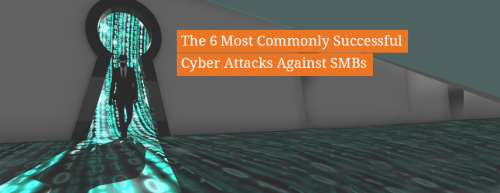

2018/12/15 IT & Cyber-Security Solutions 1941 visit(s)
Ctelecoms

As technology continues to evolve more rapidly than ever, the demand for SMBs to continuously update their policies and practices is more vital than ever. Cybercriminals are always waiting in the wings and ready to pounce at their next victim, and they will do everything to steal personal and financial information from unsuspecting people. With this in mind, neglecting network security can have costly damages to your system and even shut your company down.
Here are six most commonly successful types of cyberattacks that constantly endanger small and medium-sized businesses (SMBs):
Phishing is a method that usually involves an innocuous-looking email that appears to be from a legitimate entity (while in reality it is NOT). It utilizes social engineering tactics to create a sense of urgency in the victim.
For instance, one of your employees might receive a message seemingly from a bank. Typically, it would tell the recipient that their account has been locked, and in order to reverse this, they need to verify their account. They are then prompted to click on a link within the email.
Once the rogue URL is opened, the recipient will be greeted with seemingly harmless form that asks for details such as name, birthdate, address, and bank information. These are then transferred to cybercriminals who will use them for identity and credit card theft.
To mitigate phishing attacks, treat every email with suspicion. Don't click on any links unless you've verified the message's authenticity.
DDoS is a popular attack in which multiple sources target a web-server, website, or other known network device, and overwhelm it with a flood of messages, packets, & connection requests, causing the target to slow down or “crash”. This can be dangerous to your company, because if your website, email, or other system becomes unavailable, there will be no way for your customers to reach you.
Enabling specialized protection on all of your web-accessible servers can prevent DDoS attacks, and this can be done by limiting certain network traffic or utilizing IP loggers.
Malware is an abbreviated term meaning “malicious software.” This software is specifically designed to gain access or damage a computer without the knowledge of the owner. There are various types of malware including spyware, adware, keyloggers, true viruses, worms, or any type of malicious code that infiltrates a computer.
It's a good idea to keep your systems up-to-date, and install anti-malware and antivirus programs. Train your staff to stay away from sites that are the most common sources of malicious code. If this doesn’t seem to work out for you, Ctelecoms can help you monitor the firewall, switches and anti-virus to detect and stop any malware or suspicious activity. Moreover, if a malware comes from any globally known intruder groups that hit your network, our threat intelligence will pick up on that traffic and will alert you in an incident ticket with remediation steps to follow.
Handling passwords is tricky, as their strength can vary from one user to another. With that being said, criminals can perform brute force attacks to try to gain entry into your network.
This method uses various combinations of usernames and passwords until a system is infiltrated. Cybercriminals can utilize automated software to generate a large number of guesses, or test commonly used passwords such as “12345678” or “qwertyuiop”.
It is advisable that your organization take advantage of multi-factor authentication (MFA), and use complex, unguessable passwords to reduce the chances of a successful attack.
Inside attacks are on the rise more than ever. They often come from trusted users, employees, & external contractors that have specific authorized access on a network. Often times in insider attacks the following occurs: Unintentional mistake that affects one or more components on the network, trying to ascertain specific data that they do not have access to, checking the network for weaknesses, intentionally trying to cause harm or disruption to a business (often times this happens with a former or current disgruntled employee).
The nature of the inside attack makes them difficult to prevent: how does the organization provide individuals with the access to the information that is required to adequately do their job, while protecting the crucial information resources of the company? The answer is simple: Microsoft 365! Microsoft 365 gives you enterprise-grade user and admin controls to further secure your environment and prevent any sensitive data from being mistakenly or intentionally sent to unauthorized people.
Although most hackers target a huge number of people with a single attack, there are some who zero in on individuals to increase their success rate. APT attacks are especially scary because a hacker's main goal is usually to remain undetected on your system for an extended period.
To stay protected, you'll need to monitor your network regularly for any intrusions. You might also need to conduct network audits to see if there are vulnerabilities that can be patched. Having multiple layers of security for your firm will go a long way. Each one will safeguard from a specific type of attack and work in conjunction with other security solutions to protect your office.
Remember that protection from threats starts with awareness. All things considered, your business should always be prepared during these attacks. You can also partner with Ctelecoms to help you monitor and secure your entire IT infrastructure. Drop us a line today and let's make security work better for you.